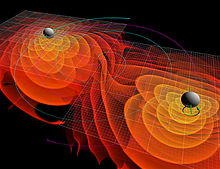User:Nisan4virgo/sandbox
Science case of Advanced Virgo interferometer[edit]

The Advanced Virgo interferometer aims to detect and study gravitational waves from astrophysical sources in the Universe. The main known gravitational-wave emitting systems within the sensibility of ground-base interferometers are: black hole and/or neutron star binary mergers, rotating neutron stars, bursts and supernovae explosions, and even the gravitational-wave background due to the Big Bang. Moreover, gravitational radiation may also lead to the discovery of unexpected and theoretically predicted exotic objects.
Coalescences of black holes and neutron stars[edit]

When two massive and compact objects such as black holes and neutron stars start spinning one around the other during the inspiral fase, they emit gravitational radiation and, therefore, lose energy. Hence, they begin to get closer to each other, increasing the frequency and the amplitude of the gravitational waves: it is the coalescence phenomenon and can last for millions of years. The final stage is the merger of the two objects, eventually forming a black hole. The part of the waveform corresponding to the merger has the largest amplitude and highest frequency. It can only be modeled by performing numerical relativity simulations of these systems. The interferometer is designed to be sensitive to the late phase of the coalescence of black hole and neutron star binaries: only between several milliseconds and a seconds of the whole process can be observed. All detections so far have been of black hole or neutron star mergers.
Rotating neutron stars[edit]
Neutron stars are the second most compact known object in the Universe, right after black holes. They have approximately one and a half masses as our Sun, but contained within a sphere of approximately 10-km of radius. Pulsars are special cases of neutron stars that emit light pulses periodically: they can spin up to 1000 times per second. Any small deviation from axial symmetry (a tiny "mountain" on the surface) will generate continuous gravitational waves. Advanced Virgo has not detected any signal from known pulsar, which concludes that the deviation from perfect spinning balls is less than 1 mm.
Bursts and supernovae[edit]
Any signal lasting from a few milliseconds to a few seconds is considered a gravitational wave burst. Supernovae explosions, the gravitational collapse of massive stars at the end of their lives, emit gravitational radiation that can be seen by the Advanced Virgo interferometer. A multi-messenger detection (electromagnetic and gravitational radiation, and neutrinos) would help to better understand the supernovae process and the formation of black holes.
Gravitational-wave stochastic background[edit]
The Cosmic Microwave Background (CMB) is the earliest time of the Universe that can be observed in the electromagnetic spectrum. However, cosmological models predict the emission of gravitational waves generated instants after the Big Bang. Because gravitational waves interact very weakly with matter, detecting such background would give more insight in the cosmological evolution of our Universe.
Moreover, an astrophysical background must result from the superposition of all faint and distant sources emitting gravitational waves at all times, that would help to study the evolution of astrophysical sources and star formation.
Exotic sources[edit]
Non conventional, alternative models of compact objects have been proposed by physicists. Some examples of these models can be described within General Relativity (quark and strange stars, boson and Proca stars, Kerr black holes with scalar and Proca hair), arise from some approaches to quantum gravity (cosmic strings, fuzzballs, gravastars), and also come from alternative theories of gravity (scalarised neutron stars or black holes, wormholes). Theoretically predicted exotic compact objects could now be detected and would help to elucidate the true nature of gravity or discover new forms of matter. Besides, completely unexpected phenomena may be observed, unveiling new physics.


Gravitational wave polarization[edit]
Gravitational waves have two polarization: "plus" and "cross" polarization. The polarization depends on the nature of the source (for instance, precessing spins in a black hole binary merger generate gravitational waves with "cross" polarization). Therefore, detecting the polarization of the gravitational radiation would give more insight in the physical properties of the system.

